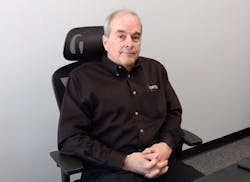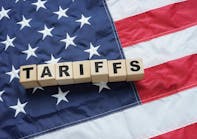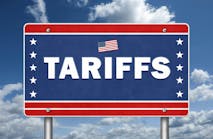Larry Keith rose from shop floor to CEO's office
By Bruce Geiselman
At just 22 years old, high school graduate Larry Keith was making metal parts in a shop he’d built himself as a teenager. That work would lead him on a path to becoming CEO of Entek, which makes battery separator film, as well as extruders and extruder parts.
He credits Entek founder Jim Young with mentoring him, teaching him about engineering and business skills. Young developed a one-step process for producing lead acid separator membrane for batteries.
In the 1990s, Keith helped Entek expand beyond battery separators to launch a new business manufacturing twin-screw extruders and extruder replacement parts.
Entek has expanded over the years from its beginnings in Lebanon, Ore., the current company headquarters, to operate manufacturing facilities worldwide. Between its two business units — making battery separator sheet/film and manufacturing extruders and replacement parts — Entek has operations in Lebanon; Henderson, Nev.; Placentia, Calif., Wake Forest, N.C.; Newcastle-Upon-Tyne, U.K.; Haryana, India; Tianjin, China; Singapore; Jakarta, Indonesia; Tsu, Japan; and Tarui, Japan. The company recently announced plans for a battery separator plant in Terre Haute, Ind.
Entek manufactures not only battery separators for lead acid batteries but also lithium batteries used in today’s electric vehicles.
In a recent interview with Plastics Machinery & Manufacturing Senior Reporter Bruce Geiselman, Keith discussed the growth of the company, his plans for the future, and what he believes is the need for more vocational education.
Tell me about your first job.
Keith: When I was 13 years old, my neighbor [Glenn Welliver] owned a machine and fabrication shop, and I used to walk down to his facility when I was in the seventh grade. I started out cleaning the shop. I was very mechanically inclined, and he started teaching me how to weld and how to be a machinist.
He was a retired engineering professor. He started teaching me engineering, and I worked for him for about 10 years. I built my own shop along that path. When I was 16, I bought my first piece of property. I built a shop building on that property with my own hands, and I started making parts for Jim Young, the founder of Entek, as a vendor to him.
How did you go from being a supplier to Entek to running the company?
Keith: Young came along and said, “I’m going to sell a bunch of [production] lines to General Motors” — that was when we thought we were going to sell the equipment [for manufacturing battery separators]. “I need you to build these lines for me.”
I was about 22 years old. I told him, “I’m not set up to build millions of dollars’ worth of production lines. I’m 22 years old. I don’t know how to cut payroll.” So, he said, “Why don’t you come to work for me?” and I went to work for him.
Shortly after I went to work for Jim, GM came back to us and said, we really like your product, but we do not want to own battery separator lines, they are too complex. However, we will buy separator from Entek and are willing to provide you with a long-term offtake agreement. So, we changed direction and built our first separator plant in Lebanon, Oregon. We designed, built, installed, and commissioned the lines for 24/7 production. I then started the machine shop.
We didn’t have a plant, but we had a little R&D line that we ran demonstrations on. That is where GM received parts from. We bought some property with a building on it in Lebanon in November 1986. We took control of it Jan. 1, 1987, installed our first line of six, and we shipped our first load of battery separator out of there on July 4, 1987. It was a very short period, but we had a prototype line, and we moved there, and that is where we started supplying product from. Then we built the plant in the U.K.
I started there when I was 23, and Jim saw something in me, took me under his wing, and he started teaching me the business side of the company — the whole P&L piece of it, the budgets, and he took me on trips to customers and taught me the negotiation side. He was a mentor to me for years and years. He was a best friend of mine, and he was a father figure.
Eventually, I became partners with Jim on the machinery [extruder manufacturing] side. I became partners with him in 2007 when we split the companies apart. Jim and I kept the extrusion company, and my brother [Rob] took the separator company. In 2011, we put it all back together, and I bought out Jim and Rob’s six partners.
[Larry Keith; Rob Keith, president of the separators division, and Richard W. Pekala, chief technology officer, are current company owners]
What prompted Entek to expand from making battery separators to also manufacturing twin-screw extruders and extruder replacement parts?
Keith: We could not get the [extruder] parts we needed [for the battery separator business]. Our product for the lead acid battery separator has a lot of silica in it — it’s basically beach sand — and it was eating the screws and barrel up. Some of the lines only ran a couple of weeks, and the barrels and screws were shot. We had five extruders in our plant, and we were taking barrels and screws off of them to stay in business.
When we found we weren’t going to be able to buy the parts [without about a 9-month wait], [Young] came to me and asked if I could do something about it. We took the screws over into the shop and we overlaid them. I did it personally with a TIG [tungsten inert gas] welder and overlaid the screws and machined them with a tool post grinder and a lathe in our shop to keep us going. The first shot that I did with the screws lasted 3 to 4 months, and it was like, “Wow, something that we did made them last longer.”
We started looking at the metallurgy. We bought a vertical milling machine and a lathe, and we started making parts in-house for ourselves. That’s what got us into making the twin-screw parts — it was survival.
Once people in the [plastics] industry heard that we were making our own parts, they started calling up to say: “We broke a set of shafts. Do you have a spare?” We said, “We do, but we’re not in the business of selling parts.” That’s when the light bulb came on. Then I went to NPE with a small booth, showed a bunch of wear parts, and we got a lot of requests. I came back and [said], “There’s a business here.”
What is the largest part of your business today?
Keith: The battery separator is still the largest, and it will always be now with a new plant coming. [Entek has received a $200 million federal grant to help pay for battery separator plants. One will be located in Terre Haute, Ind.; Alabama is also under consideration. Keith said the company may end up building plants in both states due to increased demand for lithium batteries for electric vehicles, and to protect the supply chain in case of natural disaster or other disruption.]
What prompted Entek to open a manufacturing facility in Henderson, Nev., which it unveiled in February?
Keith: We hired a company to research labor availability. We really thought it was going to end up being in Arizona because there’s a lot of aerospace there. They came back and said, Henderson, Nev., of all places.
We asked, “Really?” We placed a bunch of ads online and in social media to see what type of response we would get, and we got a ton of responses for every one of the positions. We said, “This is real.”
Kim [Entek President Kimberly Medford] and I came down and looked at 10 or 12 buildings in the area. This building was available, and it was sized right. We immediately signed a lease, and that’s where it started.
Your route to becoming CEO of a multinational company was rather unconventional. Do you think your lack of a college degree was an asset or a hindrance?
Keith: If I had my life to redo, I’d do the same thing. It led me to a great place. I don’t have a degree in engineering, but I had 10 years of somebody that was an engineering instructor working with me. I had mentors that gave me one-on-one instruction from engineering to machining to welding to business school. I think I got a different type of degree.
Is the educational system in the United States preparing people to work in industries like yours?
Keith: I would say, on the West Coast, no. Oregon has killed their vocational education.
Alabama is by far the best education that I’ve ever experienced. They start out in grade school teaching you about industry. The education system and the system to support industry far exceeds anything I’ve ever seen. They have got it figured out.
You can get a four-year-degree in two years. They let you start in high school in a work program working for industry and doing online education. When you get out of high school, you’ve got a two-year degree, and they’ve got schools like [the University of] Alabama set up to finish your four-year-degree in two years. So, in high school, you’ve got two years of working in factories and then you go get the rest of it.
They have technical centers in Alabama where they have robotics, PLC, RDID, and material handling in one building we visited. They have shipbuilding in the southern part of Alabama, and they have aerospace. Those are technical centers and colleges.
The problem with Oregon is the unions have killed all the vocational ed or made it go away. You get kids that are 10th, 11th or 12th grade that don’t want to get four-year degree and would rather be a pipe fitter. Well, they have no outlet to go do that. Or they would rather be an electrician, so they just drop out of school. Kids that have an alternate path to go work with their hands or have a different type of degree, a maintenance guy or something, they don’t drop out of school. They go: “Hey, I see a path here.” That path starts in high school in those Midwest states, and their dropout rate is much better than it is for areas that don’t have it.
I had small engines and metal working in junior high school. When I got to high school, I had large engines, metalworking, machining and welding. I built a drift boat in my woodworking class and grandfather clocks. That doesn’t exist today. I was very mechanical and got that opportunity young.
How has the extruder manufacturing industry changed over the past 37 years?
Keith: We were one of the first companies that pioneered putting the controls onboard a machine. When we were buying machines, you would get control panels that would come separate from the machine. Then you had to run all the conduit, run all the interconnect wiring in the field and then wring it all out. When we began building machines for ourselves, we said, “Why don’t we put the controls right onboard so that we’re not doing all the interconnected wiring in the field?” That was probably the biggest change at that point in time.
And then with barrels, we used to throw the barrels away when they were worn out. We [were] throwing a lot of metal away. So, we developed the sleeving process to make barrel sleeves. I also think the metallurgy has changed. It’s gotten better. We spent a lot of money on developing metallurgy. We blend powder metals in house.
What major challenges have you faced as Entek has grown?
Keith: One of them was after 9/11. Being in the capital goods business was very tough. We had some big projects that we were doing, but the phones quit ringing at that point in time. I think that really shook this country up.
We had just built the building that we’re in today [in Lebanon, Ore.]. We just bought several million dollars’ worth of equipment for our new shop, and then 9/11 hits. It was a tough time.
I would say 2008 was not nearly as tough for us because we had been through a crisis in 2001 when 9/11 hit. So, we were prepared for it. It wasn’t fun to go through, but we had no debt, and we just went right through the thing and came out the other side just fine. We didn’t lay people off in 2008 and 2009. We kept everybody. We weren’t going to lay off the talent that we invested in. We just didn’t do it.
What are some of the most important milestones the company has achieved?
Keith: One of the product lines for the separator division that we developed was a thin separator. It was 0.15 backweb. All our competitors were making 0.25 and 0.20, so we made a product called RhinoHide. It was thin and tough, and it performed as well as the thicker [product]. We were able to use less material, go faster and make a one-stage process. Our competitors would extrude black sheet and then take it to somewhere else and extract it or they would make pellets, then make black sheet and slit it. We were a one-step process all the way through. That was a huge advantage at the time. But the thin material, we're still the largest producer of 0.15 backweb material in the world.
(The backweb is the area of the sheet that doesn't have ribs on it in the lead acid battery.)
What problems have to be overcome when it comes to electric vehicles?
Keith: I think the big thing is, how do you generate electricity that is carbon neutral. There are not very many choices today: you’ve got wind, solar, nuclear and hydro. But, if you look at where the power is made, it is coal and natural gas. That's a challenge to get over.
Does the technology exist to use solar and wind to generate enough electricity for what you need to do?
Keith: I don't believe we can. I don't think there's enough land and wind here. I think it's going to be other things.
Nuclear?
Keith: Definitely. You see these new micro-nuclear plants that people are starting to look at. There's one in Oregon at OSU [Oregon State University]. I think you're going to see more of that happening. I think nuclear is going to come back. Everybody got scared because of Three Mile Island, but that's an old technology, and I think that there's been a lot of effort put into making nuclear safe.
To what do you attribute Entek's success?
Keith: Having great core values, finding really good people, and treating them well is the key to success.
I'm sure that running Entek keeps you busy, but outside of work, do you have any hobbies?
Keith: I'm a pilot; I fly. I have for about 30 years. I like to fish when I can find time, and bird hunt. And we have a wakeboard boat. We go out in the summertime on the lake here or other places, and we do wake surfing.
How would you like to be remembered?
Keith: The founder, when he sold me the company, said, “I want you to run this company so that it'll be here 100 years after you're gone.”
I want the company to be here 100 years after I'm gone, and I want the people behind me to have the same opportunity I had and run the company like it'll be around 100 years after that.
Bruce Geiselman, senior staff reporter
JUST THE FACTS
Who is he: Larry Keith, Entek CEO
Education: South Salem High School, Salem, Ore., 1980
Years in the plastics industry: 37
Joined Entek: 1986 and became CEO in November 2011
Age: 60
Headquarters: Lebanon, Ore.
Employees: 1,000 globally
Bruce Geiselman | Senior Staff Reporter
Senior Staff Reporter Bruce Geiselman covers extrusion, blow molding, additive manufacturing, automation and end markets including automotive and packaging. He also writes features, including In Other Words and Problem Solved, for Plastics Machinery & Manufacturing, Plastics Recycling and The Journal of Blow Molding. He has extensive experience in daily and magazine journalism.
Request More Information






